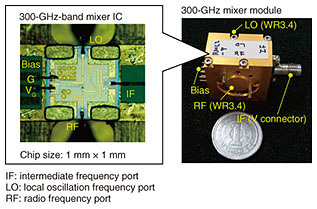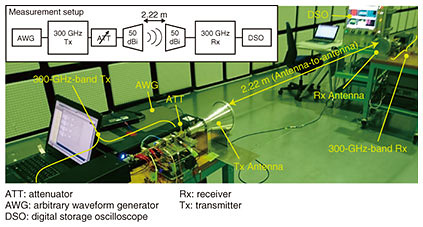 |
|||
|
|
|||
|
Short Reports Vol. 16, No. 11, pp. 63–65, Nov. 2018. https://doi.org/10.53829/ntr201811sr1 Ultrahigh-speed Integrated Circuit Capable of Wireless Transmission of 100 Gbit/s in the 300-GHz Band1. IntroductionNTT and Tokyo Institute of Technology have jointly developed an ultrahigh-speed integrated circuit (IC) for wireless front-end that operates on a terahertz frequency band, and they have succeeded in developing the world’s fastest 100-Gbit/s wireless transmission data rate in the 300-GHz band. Unused terahertz waves* are expected to be applicable to high-speed wireless transmission since a wide frequency band can be secured. In our research, we implemented a mixer circuit that applied a unique proprietary high isolation design technology with an Indium phosphide high electron mobility transistor (InP-HEMT). This enlarged the transmission bandwidth, which is a problem in the conventional 300-GHz-band wireless front end. It also improved the signal-to-noise ratio (SNR). In addition, we used this circuit to develop a 300-GHz-band wireless front-end module, and we achieved wireless transmission of 100 Gbit/s. In this research, we achieved 100-Gbit/s wireless transmission with one wave (one carrier), so in the future, we can extend this idea to multiple carriers by making use of the wide frequency band of 300 GHz and using spatial multiplexing technology such as multiple-input multiple-output (MIMO) and orbital angular momentum (OAM). Ultrahigh-speed IC technology is expected to enable high-capacity wireless transmission of 400 Gbit/s. This is about 400 times that of the current LTE (Long-Term Evolution) and Wi-Fi, and 40 times that of 5G (fifth-generation mobile communications system) technology. Ultrahigh-speed ICs are also expected to open up utilization of the unused terahertz wave frequency band in the communications field and in non-communications fields.
2. Research backgroundHigh-capacity wireless transmission technology of 100 Gbit/s has attracted worldwide attention with the spread of broadband networks. There are three ways of further increasing the capacity of wireless transmission—expanding the transmission bandwidth, increasing the modulation multi-level number, and increasing the spatial multiplexing number. To realize future large capacity wireless transmission technology from a level of 400 Gbit/s to that of one terabit per second (Tbit/s), it is necessary to expand both the transmission bandwidth and the modulation multi-level number simultaneously in one wave (one carrier) and to increase the number of spatial multiplexing transmissions by superimposing them multiple times. The transmission bandwidth is limited in the carrier frequencies from 28 GHz to 110 GHz that are currently being researched and developed. Thus, researchers are studying the use of frequencies that make it easier to expand the transmission band area, from the 300-GHz band to the terahertz wave frequency band. The 300-GHz band has a frequency that is 10 times or more higher than the 28-GHz band that is being studied for 5G, which will be the next generation mobile communications technology. With the 300-GHz band, it will be easier to secure a wide transmission bandwidth. However, at high frequencies, leakage of unnecessary signals tends to occur between the ports inside the IC and the mounting, and so far, it has been impossible to obtain a sufficiently high SNR. For this reason, even if a 300-GHz band is used, it is impossible to obtain both a wide transmission bandwidth and a high modulation multi-level value at the same time, and so wireless transmission up to now has remained at the rate of several tens of gigabits per second. 3. Research resultsIn this research, we devised our own high isolation design technology and applied this technology to a mixer circuit, which is a key component responsible for frequency conversion in the 300-GHz-band wireless front end. We also developed an IC with an InP-HEMT. By applying high isolation design technology, we succeeded in suppressing leakage of unnecessary signals inside each IC and between ports in the IC. We also succeeded in improving signal noise reduction and expanding the bandwidth, which had been issues confronting the use of conventional 300-GHz-band wireless front-end technology until now. With these technologies, we also developed a 300-GHz-band wireless front-end module (Fig. 1), and we confirmed reception of a good 16QAM (quadrature amplitude modulation) signal in back-to-back transmission. In the 300-GHz band, we also confirmed transmission at a speed of 100 Gbit/s, the first time in the world this speed has been attained (Fig. 2).
4. Future prospectsIn our research, we achieved 100-Gbit/s transmission with one wave (one carrier), so in the future we will expand our research to use multiple carriers or spatial multiplexing technology such as MIMO and OAM together with this result. With this combination, we expect to achieve ultrahigh-speed IC technology that enables high-capacity wireless transmission of over 400 Gbit/s. In addition, we expect that our approach will be applicable in various fields such as imaging and sensing in which terahertz waves are expected to be used. Through collaboration with partners, NTT aims to create new services and new industries using ultrahigh-speed ICs, and also aims to further develop ultrahigh-speed IC technology. For InquiriesNTT Science and Core Technology Group |
|||


